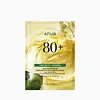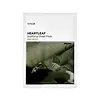What's inside
What's inside
 Key Ingredients
Key Ingredients

 Benefits
Benefits

 Concerns
Concerns

No concerns
 Ingredients Side-by-side
Ingredients Side-by-side

Houttuynia Cordata Extract 80%
Skin ConditioningButylene Glycol
HumectantWater
Skin ConditioningDipropylene Glycol
Humectant1,2-Hexanediol
Skin ConditioningGlycerin
HumectantHydroxyacetophenone
AntioxidantCellulose Gum
Emulsion StabilisingCarbomer
Emulsion StabilisingAllantoin
Skin ConditioningPolyglyceryl-10 Laurate
Skin ConditioningCitric Acid
BufferingArginine
MaskingDisodium EDTA
Betaine
HumectantPanthenol
Skin ConditioningBiosaccharide Gum-1
HumectantTheobroma Cacao Extract
Skin ConditioningSodium Hyaluronate
HumectantDextrin
AbsorbentHydrolyzed Hyaluronic Acid
HumectantSodium Acetylated Hyaluronate
HumectantHouttuynia Cordata Extract 80%, Butylene Glycol, Water, Dipropylene Glycol, 1,2-Hexanediol, Glycerin, Hydroxyacetophenone, Cellulose Gum, Carbomer, Allantoin, Polyglyceryl-10 Laurate, Citric Acid, Arginine, Disodium EDTA, Betaine, Panthenol, Biosaccharide Gum-1, Theobroma Cacao Extract, Sodium Hyaluronate, Dextrin, Hydrolyzed Hyaluronic Acid, Sodium Acetylated Hyaluronate
Houttuynia Cordata Extract
Skin ConditioningGlycerin
HumectantWater
Skin ConditioningDipropylene Glycol
HumectantGlycereth-26
Humectant1,2-Hexanediol
Skin ConditioningArginine
MaskingCaprylyl Glycol
EmollientPropanediol
SolventIllicium Verum Fruit Extract
PerfumingAllantoin
Skin ConditioningSodium Hyaluronate
HumectantCentella Asiatica Extract
CleansingChamomilla Recutita Flower Extract
MaskingHippophae Rhamnoides Fruit Extract
Skin ConditioningHamamelis Virginiana Leaf Extract
Skin ConditioningCeramide NP
Skin ConditioningGlycosphingolipids
EmollientHydrogenated Lecithin
EmulsifyingCarbomer
Emulsion StabilisingXanthan Gum
EmulsifyingPolyglyceryl-4 Caprate
EmulsifyingEthylhexylglycerin
Skin ConditioningDisodium EDTA
Squalane
EmollientHouttuynia Cordata Extract, Glycerin, Water, Dipropylene Glycol, Glycereth-26, 1,2-Hexanediol, Arginine, Caprylyl Glycol, Propanediol, Illicium Verum Fruit Extract, Allantoin, Sodium Hyaluronate, Centella Asiatica Extract, Chamomilla Recutita Flower Extract, Hippophae Rhamnoides Fruit Extract, Hamamelis Virginiana Leaf Extract, Ceramide NP, Glycosphingolipids, Hydrogenated Lecithin, Carbomer, Xanthan Gum, Polyglyceryl-4 Caprate, Ethylhexylglycerin, Disodium EDTA, Squalane
 Reviews
Reviews

Ingredients Explained
These ingredients are found in both products.
Ingredients higher up in an ingredient list are typically present in a larger amount.
1,2-Hexanediol is a synthetic liquid and another multi-functional powerhouse.
It is a:
- Humectant, drawing moisture into the skin
- Emollient, helping to soften skin
- Solvent, dispersing and stabilizing formulas
- Preservative booster, enhancing the antimicrobial activity of other preservatives
Allantoin is a soothing ingredient known for its protective and moisturizingg properties. Because of this, it is often added to products with strong active ingredients.
Studies show higher concentrations of this ingredient can promote wound healing.
Though it can be derived from the comfrey plant, allantoin is produced synthetically for cosmetic products to ensure purity.
Learn more about AllantoinArginine is an amino acid that is important for human development. Your body uses is it to produce hair keratin and skin collagen.
As a cosmetic ingredient, Arginine has antioxidant properties and can also help repair damaged skin. This ingredient is derived either synthetically or from animals.
Arginine isn't fungal acne safe when used in the presence of other lipids (fats, fatty acids, oils, esters, etc). Oils and fats occur naturally within the skin, so take caution when using Arginine if you're prone to fungal acne.
Learn more about ArginineCarbomer is a polymer of acrylic acid. Its main role is to create a gel consistency.
A high amount of carbomer can cause pilling or balling up of products. Don't worry, most products contain 1% or less of carbomer.
Dipropylene Glycol is a synthetically created humectant, stabilizer, and solvent.
This ingredient helps:
Dipropylene glycol is technically an alcohol, but it belongs to the glycol family (often considered part of the ‘good’ alcohols). This means it is hydrating and gentle on skin unlike drying solvent alcohols like denatured alcohol.
As a masking agent, Dipropylene Glycol can be used to cover the smell of other ingredients. However, it does not have a scent.
Studies show Dipropylene Glycol is considered safe to use in skincare.
Learn more about Dipropylene GlycolDisodium EDTA plays a role in making products more stable by aiding other preservatives.
It is a chelating agent, meaning it neutralizes metal ions that may be found in a product.
Disodium EDTA is a salt of edetic acid and is found to be safe in cosmetic ingredients.
Learn more about Disodium EDTAGlycerin is already naturally found in your skin. It helps moisturize and protect your skin.
A study from 2016 found glycerin to be more effective as a humectant than AHAs and hyaluronic acid.
As a humectant, it helps the skin stay hydrated by pulling moisture to your skin. The low molecular weight of glycerin allows it to pull moisture into the deeper layers of your skin.
Hydrated skin improves your skin barrier; Your skin barrier helps protect against irritants and bacteria.
Glycerin has also been found to have antimicrobial and antiviral properties. Due to these properties, glycerin is often used in wound and burn treatments.
In cosmetics, glycerin is usually derived from plants such as soybean or palm. However, it can also be sourced from animals, such as tallow or animal fat.
This ingredient is organic, colorless, odorless, and non-toxic.
Glycerin is the name for this ingredient in American English. British English uses Glycerol/Glycerine.
Learn more about GlycerinHouttuynia Cordata Extract is more commonly known as Heart Leaf, Fish Mint, or Chameleon plant.
The components found in Heart Leaf give it antioxidant, hydrating, antimicrobial, and anti-inflammatory properties.
Heart Leaf is rich in flavonoids such as quercetin, apigenin, and more. It also contains polysaccharides, the most common type of carbs in food.
Flavonoids have been shown to be effective antioxidants. They help neutralize free-radical molecules. Free-radical molecules are unstable molecules that may damage our skin cells and DNA. The flavonoids in Heart Leaf also help soothe the skin.
Polysaccharides are naturally found in our skin. They play a role in hydrating and repairing the top layer of skin. The polysaccharides in Heart Leaf help moisturize our skin.
Studies show decanoyl acetaldehyde, a component of Heart Leaf oil, is effective at killing bacteria.
The name 'Fish Mint' comes from the herb's natural fishy smell. Is is native to southeast Asia and used throughout the continent for traditional cooking and medicine.
Learn more about Houttuynia Cordata ExtractSodium Hyaluronate is hyaluronic acid's salt form. It is commonly derived from the sodium salt of hyaluronic acid.
Like hyaluronic acid, it is great at holding water and acts as a humectant. This makes it a great skin hydrating ingredient.
Sodium Hyaluronate is naturally occurring in our bodies and is mostly found in eye fluid and joints.
These are some other common types of Hyaluronic Acid:
Learn more about Sodium HyaluronateWater. It's the most common cosmetic ingredient of all. You'll usually see it at the top of ingredient lists, meaning that it makes up the largest part of the product.
So why is it so popular? Water most often acts as a solvent - this means that it helps dissolve other ingredients into the formulation.
You'll also recognize water as that liquid we all need to stay alive. If you see this, drink a glass of water. Stay hydrated!
Learn more about Water